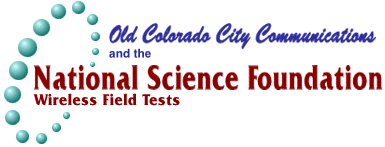
|
Voice 719.636.2040 · Fax 719.528.5869 ·Wireless Web http://wireless.oldcolo.com | ||
|
|
                                              |
 General Scope of Tests Locus Participants Method Key Personnel Contractual METHOD:This Project seeks to test wireless connections under practical-use field conditions. To the extent practicable the network configurations will duplicate the configurations which would be used if the networks were all wired. The basic measurments will determine:
Data will be kept on weather and environmental conditions to be correlated with performance of wireless networks. Data will be kept on the frequency of necessary wireless net troubleshooting episodes. Typical end user data and network functions will be exercised. Such as text, text and graphics, web page access, sound, online voice, CuSeeMe sessions, compressed video and whiteboard sessions. The proposal procures currently used software and equipment used to generate such data. As supported by the equipments utilized, data will be collected on radio link data transmission performance. These statistics are valuable in determining how radio performance differs from that of wirelines, e.g., what external performance parameters might be adjusted to get better throughput, what protocol enhancements might be considered in next generation wireless equipments, or what the end-to-end throughput is as a percentage of channel rate. Little actual experience data is published for radio systems of the kind proposed. Theories abound, particularly regarding the efficiency of certain protocols. Even the small amount of data this Project is likely to produce will add significantly to the available body of knowledge. The collected data will be reviewed and analyzed, preliminary findings drawn up by the end of the first half of Phase 2 and publicized in web page as well as ftp, modem dial up, accessible form on Old Colorado City's Internet servers - as preliminary findings. Adjustment to tests which produced inconclusive results, and additional tests will be performed the second half of Phase 2. The final data will be collected and analyzed at the end of Phase 2. The final report will be in two forms. The NSF Report according to its requirements, and a highly readable report that presents the data, the findings, but also the 'factors' which have to be considered in employing wireless devices into networks. This report will be both put online in Web format and published as a Guide to Wireless for distribution. The public report will be rewritten by a professional technical writer/publisher who will produce in specified number of copies - 2,500 being a practicable target, for on-demand distribution.
Equipment and networks will remain in place, so that
'extended data' can be collected by the partipating institutions
after the formal phases of this Project are complete, in return for
the continued use of the equipment. (the financial responsibility
for continued connection to commercial networks will shift, however
to the participating institutions.)


|

